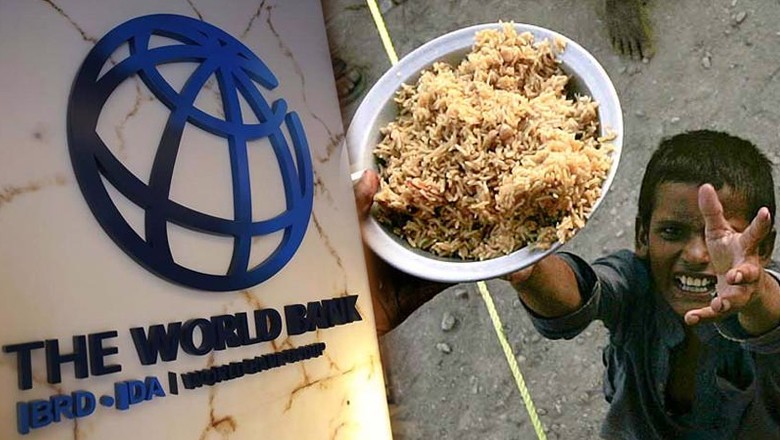Islamabad: The World Bank has issued a stark warning, projecting that nearly 10 million Pakistanis could face acute food insecurity during the current fiscal year, primarily due to economic challenges and climate-related disruptions in agriculture.
This alarming forecast coincides with a downward revision of Pakistan’s economic growth estimate to just 2.7% for the year, signaling a tough period ahead.
In its Pakistan Economic Update, the World Bank emphasized that Pakistan’s poverty levels are expected to rise, with the government likely to miss its annual budget deficit target.
The report also highlighted that the country’s debt burden will continue to grow, both in absolute terms and as a proportion of GDP.
Climate Impact on Agriculture
The report pointed to adverse climatic conditions affecting key crops, such as rice and maize, which are central to the country’s agricultural output.
As a result, food insecurity is expected to hit rural areas the hardest, with 10 million people anticipated to experience high levels of acute food insecurity during FY25.
The bank stressed that issues such as food insecurity, poverty, unemployment, and stagnant real wages are not frequently highlighted in official discussions but remain critical to Pakistan’s economic stability.
Stagnation in Key Sectors
The World Bank also noted that critical sectors for the poor, including agriculture, construction, and low-value-added services, are experiencing low or negative growth, leading to stagnant real wages.
This economic stagnation, combined with a 2% population growth, is expected to push approximately 1.9 million more people into poverty by the end of this fiscal year.
The report further emphasized that the country’s employment-to-population ratio stands at 49.7%, reflecting a low level of labour market engagement, particularly among youth and women.
The absence of significant social protection expenditures has compounded these issues, limiting resources available for essential needs such as food, healthcare, and education.
Stagnant Real Wages
Despite an increase in nominal daily wages for low-skilled workers such as masons, plumbers, and painters, real wages remain stagnant or have even decreased slightly.
Consequently, the official poverty headcount is projected to rise, with an estimated 25.4% of the population living below the national poverty line by the end of the fiscal year.
Economic Growth Outlook
The World Bank’s projection of 2.7% economic growth for this fiscal year aligns with forecasts from the International Monetary Fund (IMF) and the Asian Development Bank (ADB).
This means that Pakistan will miss its 3.6% growth target, which had been deemed achievable by Finance Minister Muhammad Aurangzeb in the annual budget.
According to Najy Benhassine, the World Bank’s Country Director for Pakistan, the country faces the challenge of translating recent stabilization gains into sustainable economic growth that can adequately address poverty.
He stressed the need for high-impact reforms in taxation, exchange rates, business environment improvements, and government streamlining to build investor confidence and stimulate economic growth.
Looking ahead, the World Bank forecasts modest growth, projecting 3.1% for the next fiscal year and 3.4% in 2027, both figures lower than the government’s target for this fiscal year.
Inflation and Current Account Surplus
The report predicts that inflation will decline to 5% this year, driven by subdued demand, lower commodity prices, and a stable exchange rate.
On the positive side, Pakistan’s current account is expected to achieve a surplus of 0.2% of GDP (around $800 million) this fiscal year, driven by strong remittances from workers abroad.
Read More: Pakistan Poverty Rate Projected at 42.4% in 2025: World Bank Report
This will help offset the growing trade deficit resulting from faster import growth compared to export growth.
Budget Deficit and Public Debt
The World Bank also projected that Pakistan’s budget deficit would exceed its target of 5.9% of GDP, reaching 6.8% of GDP in FY25.
This means the government will spend an additional Rs1.1 trillion above the budgeted amount. Public debt, including guaranteed debt, is expected to reach 74.6% of GDP by the end of the fiscal year, up from 72.7% last year.
Call for Structural Reforms
The World Bank urged Pakistan to restore the functioning of the interbank foreign exchange market and adopt a fully market-determined exchange rate. It also recommended right-sizing the government by eliminating redundant positions and agencies, as well as reviewing public sector compensation to reduce costs and increase transparency.
Anna Twum, the lead author of the report, warned that while Pakistan’s economy has stabilized, it remains fragile.
She stressed that any delays in implementing structural reforms or shifts in economic policies could hinder the country’s recovery and exacerbate external pressures.
Also Read: World Bank Slashes Growth Projections for Pakistan @2.7%
The World Bank also recommended the implementation of parametric pension reforms to reduce future liabilities and facilitate a transition to a contribution-based pension system over time.
Key Recommendations
-
Agriculture: Implement the recently revised Agriculture Income Tax and address undervaluation in property tax assessments.
-
Taxation: Reduce the number of zero-rated items under the Income Tax Ordinance and evaluate exemptions with ex-ante cost assessments.
-
Public Sector Reform: Focus on government right-sizing, simplifying in-kind benefits, and increasing transparency.
The World Bank’s report underscores the urgency of addressing Pakistan’s structural challenges and economic vulnerabilities through bold reforms to secure long-term economic stability.
